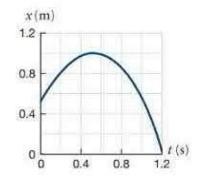Figure (mathrm{P} 2. 45) shows the (x) coordinate as a function of time for a moving object.
Question:
Figure \(\mathrm{P} 2. 45\) shows the \(x\) coordinate as a function of time for a moving object. What is the object's \(x\) coordinate \((a)\) at t=0, (b) t=0.20s, and (c) t=1.2s? What is the object's displacement \((d)\) between \(t=0\) and \(t=0.20 \mathrm{~s}\), (e) between \(t=0.20 \mathrm{~s}\) and \(t=1.2 \mathrm{~s}\), and \((f)\) between \(t=0\) and \(t=1.2 \mathrm{~s}\) ? What is the distance traveled by the object (g) between \(t=0\) and \(t=0.80 \mathrm{~s},(h)\) between \(t=0.80 \mathrm{~s}\) and \(t=1.2 \mathrm{~s}\), and \((i)\) between \(t=0\) and t=1.2s?
Data from Figure P2.45

Fantastic news! We've Found the answer you've been seeking!
Step by Step Answer:
Related Book For 

Question Posted:





